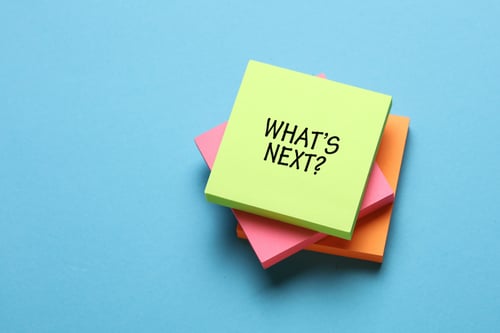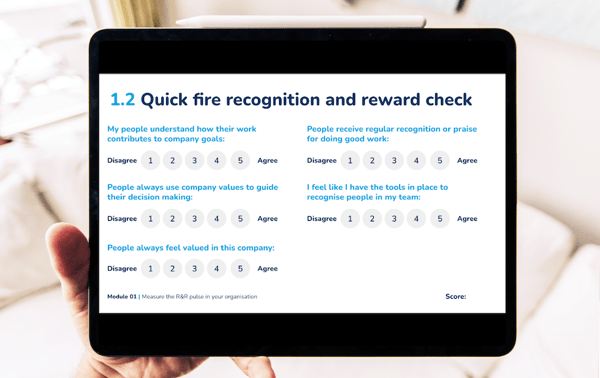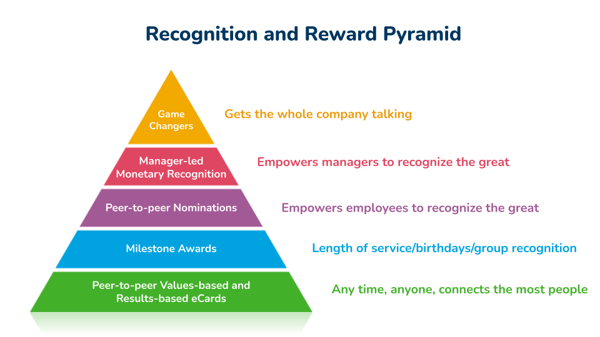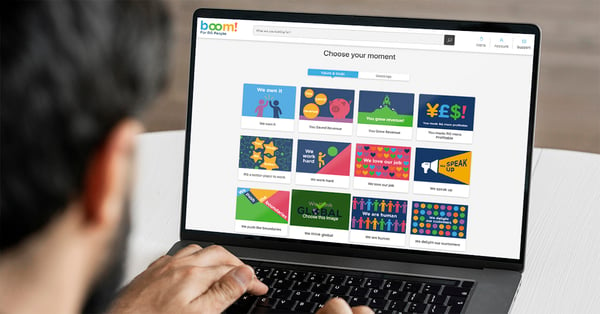Part one: 3 steps to designing a platform built for your people’s needs
Whether your organization is actively hiring or working to avoid unwanted attrition (or both), a strong reward and recognition program is a proven, high-impact way to improve employee retention and attraction. But what does it take to build a best-in-class reward and recognition experience that keeps best-in-class talent committed to your organization?
 Diving into the nitty-gritty of developing a company-wide employee recognition strategy can feel overwhelming, especially when there’s pressure to meet both expectations and budget while delivering an R&R experience that is easy to understand and perceived and consistent, fair and equal for all.
Diving into the nitty-gritty of developing a company-wide employee recognition strategy can feel overwhelming, especially when there’s pressure to meet both expectations and budget while delivering an R&R experience that is easy to understand and perceived and consistent, fair and equal for all.
If only there was a step-by-step process to follow… right?
Every company is different so there really is no such thing as a one-size-fits all approach. But after partnering with over 2,000 companies, we’ve learned a thing or two about the fundamentals of building a recognition-rich company culture and a program that your employees will embrace.
Here are the key things to build into your recognition strategy:
| 1. Measure the reward and recognition pulse of your organization |
| 2. Design your reward and recognition pyramid |
| 3. Build an unforgettable, peer-to-peer reward and recognition experience |
1. Measure the reward and recognition pulse of your organization
Before you start planning, make sure your decisions are insight-informed with a bit of recognition reconnaissance. If it’s been a while since you’ve done a formal "temperature check" of the state of reward and recognition in your business, a quick employee survey is a good way to get a sense of your employees' perception of recognition.

A survey is a great way to open up lines of communication with your people and encourage buy in from early on. Use this opportunity to help you understand areas of your existing recognition experience that your employees appreciate and want to keep and identify opportunities for improvement and change.
You can use the results to stimulate conversation in focus group sessions when the time comes to design your program, and as a benchmark to come back and visit every six months or so post-implementation to keep track of your progress!
2. Design your reward and recognition pyramid
The layers of the Recognition and Reward Pyramid illustrate different components of a strategic recognition program. It’s an easy-to-follow and easy-to-remember framework that ensures all employees in your organization have the opportunity to be seen, recognized and rewarded at least once throughout the year.

Like any solid structure, we recommend building a program from the bottom up: the bottom of the pyramid is the widest which means that element of your program is designed to reach and recognize the most number of employees. This is where the majority of recognition frequency comes from, with peer-to-peer, values-based and results-based eCards and in-person recognition. These have no monetary value attached, are fun and celebratory, continuous (that is, can be sent at any time throughout the year) and multi-directional.
As you move up the pyramid, it gets narrower, meaning that type of recognition is for a subset of your employees. The middle of the pyramid is where manager or monthly and quarterly awards sit, and the top of the pyramid cover awards that might be Employee of the Year awards or a CEO/Leadership award.
Traditional programs that focus on only annual or even monthly awards only reach some of your employees. Strategic recognition is designed to reach as many people as possible.
The layer after company-wide, everyday employee recognition is Service, Milestone or Birthday Greetings – which offer an opportunity to impact and connect employees positively throughout the year and inspire brand loyalty.
 The next tier, Peer-to-Peer Nominations, gives all employees the chance to nominate specific colleagues for a reward when they see great behavior in action. Some companies (particularly those which already have a strong culture of trust) enable employees to allocate small rewards without approval anywhere from 4-12 times per year.
The next tier, Peer-to-Peer Nominations, gives all employees the chance to nominate specific colleagues for a reward when they see great behavior in action. Some companies (particularly those which already have a strong culture of trust) enable employees to allocate small rewards without approval anywhere from 4-12 times per year.
Defining your reward and recognition budget for these instant awards can range, but something like $20-$25 is a good place to start, as that’s about the same as taking someone out to lunch or buying them a bottle of wine (of course, using a recognition platform with multiple reward redemption options means individuals get to choose what reward is best for them).
Managers usually have more flexibility and budget for their reward allocation, which gives them tools and autonomy to give recognition and reward when they see employees go above and beyond.
As with all recognition, we focus on the impact award-recipients have, so we encourage leaders to share the story behind the nomination, so that reward is clearly tied to an action.
Finally, the top tier is where the least "amount" of recognition is shared but these are typically the rewards of the highest value – they are rewards that get people talking should be tied to your company values and make a big splash!
As you start to develop your reward and recognition program, consider how you will introduce or refine the different levels of our recognition pyramid and make it your own.
3. Build an unforgettable, peer-to-peer reward and recognition experience
Name your program
This is easily one of my favorite parts of the process because I get to hear all the great reward and recognition program names and company puns that people come up with! This also doesn't necessarily need to happen first but I’ll list it here because it’s a fun step that often gets people excited.
My biggest tip here is to make sure it’s easy to spell and easy to remember (you’ll be surprised what a difference this makes when it comes to logging in to and using your R&R platform!).
Here are my three tips for naming and designing your program:
- Make it meaningful: Choose a program name that employees can easily relate to and understand.
- Make it stand out: You want employees to notice this program, to stop people in their tracks and get them excited about taking part! A stand-out name creates "stickiness" which draws people back over and over again.
- Make it last: Think about your short and long term opportunities for communication and consider a name which gives you lots of ways to grow!
Don’t rush! The goal of a great recognition program is that it is around for many years to come and that grows with your organization. Think about involving others as you go through the name development process and even invite contributions from employees – imagine the look on someone’s face when they see their name up in lights!
Lay the foundation of peer-to-peer recognition
The bottom (foundational!) tier of your recognition and reward strategy is free, everyday peer-to-peer eCards!
Giving employees a chance to recognize one another is 3x more likely to have an impact on morale and productivity than manager-only recognition.
 This is true regardless of whether the recognition involves monetary reward or not. And that’s not to say manager-recognition doesn’t matter (trust me, it does!) but a program that allows for everyday, employee-to-employee recognition will be more powerful and more frequently used.
This is true regardless of whether the recognition involves monetary reward or not. And that’s not to say manager-recognition doesn’t matter (trust me, it does!) but a program that allows for everyday, employee-to-employee recognition will be more powerful and more frequently used.
Start by deciding what type of eCards you want to create and what you’ll call them. Will they be based on your company values (we highly recommend they are!), are there company-specific moments you want to shine a light on, and any universal greetings that deserve time in the spotlight?
Once you’ve identified those key peer-to-peer moments, you can start designing your eCards and using them to bring your culture to life:

The key to building a long-lasting recognition program is your people. By gaining employee feedback, introducing a tiered approach and involving employees in choosing the platform name, you’re on your way to creating a centralized hub for your organization.
Next up, we’ll be diving into the two main ways to create an unforgettable employee experience with your R&R program to drive strong usage and adoption. Check out part two!

 George Dixon
George Dixon


